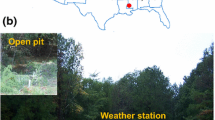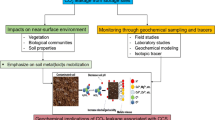Abstract
This study reports the first field test of a multi-channel, auto-dilution, steady-state, soil–CO2 flux monitoring system being developed to help understand the pathways by which fugitive CO2 from a geologic sequestration site migrates to the surface. The test was conducted from late August through mid-October 2008 at the Zero Emissions Research and Technology project site located in Bozeman, MT. Twenty steady-state and five non-steady-state flux chambers were installed in a 10 × 15 m area, one boundary of which was directly above a shallow (2-m depth) horizontal injection well located 0.5 m below the water table. A total flux of 52 kg CO2 day−1 was injected into the well for 13 days and the efflux from the soil was monitored by the chambers before, during, and for 33 days after the injection. The results showed a rapid increase in soil efflux once injection started, with maximal values reached within 3–7 days in most chambers. Efflux returned to background levels within a similar time period after injection ceased. A radial efflux pattern was observed to at least 2 m from the injection well, and evidence for movement of the CO2 plume during the injection, presumably due to groundwater flow, was seen. The steady-state chambers yielded very stable data, but threefold to fivefold higher fluxes than the non-steady-state chambers. The higher fluxes were attributed to vacuum induced in the steady-state chambers by narrow vent tubes. High winds resulted in significant decreases in measured soil CO2 efflux, presumably by enhancing efflux from soil outside the chambers.







Similar content being viewed by others
References
Amonette JE, Barr JL (2009) Multi-channel auto-dilution system for remote continuous monitoring of high soil–CO2 fluxes. PNNL-18229. Pacific Northwest National Laboratory, Richland, WA. http://www.pnl.gov/publications/abstracts.asp?report=256093. Accessed 22 Sep 2009
Gao F, Yates SR (1998) Laboratory study of closed and dynamic flux chambers: experimental results and implications for field applications. J Geophys Res 103:26115–26125
Hutchinson GL, Mosier AR (1981) Improved soil cover method for field measurement of nitrous oxide fluxes. Soil Sci Soc Am J 45:311–316
Kanemasu ET, Powers WL, Sij JW (1974) Field chamber measurements of CO2 flux from soil surface. Soil Sci 118:233–237
McGrail BP, Schaef HT, Ho AM, Chien Y-J, Dooley JJ, Davidson CL (2006) Potential for carbon dioxide sequestration in flood basalts. J Geophys Res 111:B12201
Reichman R, Rolston DE (2002) Design and performance of a dynamic gas flux chamber. J Environ Qual 31:1774–1781
Rochette P, Hutchinson GL (2005) Measurement of soil respiration in situ: chamber techniques. In: Hatfield JL, Baker JM (eds) Micrometeorology in agricultural systems. Agronomy monograph no. 47. American Society of Agronomy, Madison, pp 247–286
Soil Moisture Equipment Corporation (2000) Operating instructions: 5201F1 soil moisture G-blocks. Soil Moisture Equipment Corporation, Santa Barbara, California. http://www.soilmoisture.com/PDF%20Files/85201F1.pdf. Accessed 15 Apr 2009
Spangler LH, Dobeck LM, Repasky K et al (2009) A controlled field pilot in Bozeman, Montana, USA, for testing near surface CO2 detection techniques and transport models. Environ Ear Sci (this issue)
White CM, Strazisar BR, Granite EJ, Hoffman JS, Pennline HW (2003) Separation and capture of CO2 from large stationary sources and sequestration in geological formations—coalbeds and deep saline aquifers. J Air Waste Manag Assoc 53:645–715
White CM, Smith DH, Jones KL, Goodman AL, Jikich SA, LaCount RB, DuBose SB, Ozdemir E, Morsi BI, Schroeder KT (2005) Sequestration of carbon dioxide in coal with enhanced coalbed methane recovery—a review. Energy Fuels 19:659–724
Xu L, Furtaw MD, Madsen RA, Garcia RL, Anderson DJ, McDermitt DK (2006) On maintaining pressure equilibrium between a soil CO2 flux chamber and the ambient air. J Geophys Res 111:D08S10. doi:10.1029/2005JD006435
Author information
Authors and Affiliations
Corresponding author
Rights and permissions
About this article
Cite this article
Amonette, J.E., Barr, J.L., Dobeck, L.M. et al. Spatiotemporal changes in CO2 emissions during the second ZERT injection, August–September 2008. Environ Earth Sci 60, 263–272 (2010). https://doi.org/10.1007/s12665-009-0402-0
Received:
Accepted:
Published:
Issue Date:
DOI: https://doi.org/10.1007/s12665-009-0402-0




